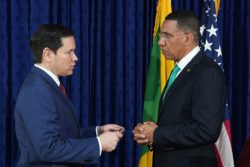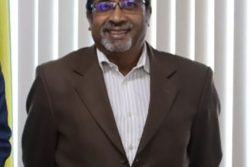Project Manager of the Hope Energy Development (HED) Inc, Johan Sydow said that with the incorporation of a solar aspect into the Hope wind farm, they are now in a position to offer power in the vicinity of US$0.07 per kilowatt-hour.
He made the disclosure on Thursday while providing an update on the project to the inaugural international oil and gas conference at the Georgetown Marriott Hotel.
HED submitted an application for an Environmental Permit for the construction and operation of the Hope Wind Farm on the 21st of September 2018.
The project proposes the construction of four wind turbines along the coast at Hope Beach, ECD, outboard of the Lowland/ Hope to Anns Grove Villages and two additional wind turbines in the Chapman’s Grove area, 2 km further to the southeast of Hope Beach. The proposed Hope Wind Farm would be the first large-scale wind energy facility to be constructed in Guyana. The base-case scenario calls for six wind turbines, each at 4.2 MW capacity, for a total 25.2 MW wind farm capacity.
The proposed wind farm is expected to annually generate over 50 Gigawatt hours (GWh) of electricity, which will be delivered to the Guyana Power and Light (GPL) grid and will lessen Guyana’s reliance on fossil fuels for power generation, reducing the emission of carbon dioxide and other pollutants. The project is slated to cost an estimated US$35 million.
During previous engagements, Sydow said that the project is not expected to hamper the growth of the mangroves in the area, as the turbines will be constructed on a large swathe of grass not too far from the shore, and will be built at least 1,000 feet from the nearest houses. He noted that it is following World Bank guidelines on how to position turbines with communities nearby.
Sydow told the conference that the project has been in the making for over 20 years and the difficulties revolved mainly around the unstable grid. Just last year, the company submitted its Environmental Impact Assessment to the Environmental Protection Agency and is now at the stage where it is in negotiation with GPL for the supply of power.
“The next step is then to finalize a PPA – the power purchase agreement – with GPL and then get on with detailed engineering and the financing of the project…once we have the PPA signed (and) I’m not putting dates on this because everything hangs on that PPA. Once we are done with that, then the timeline is in our control again and so we need about six to 12 months for the EPC design and the financing and then we get to final investment decision (and) we start construction,” he said.
He said that the HED has formed a joint venture with international partners to carry out this project, including the manufacturer of the wind turbine – Vestas Wind Systems. Vestas is a Danish company that is the largest installer of wind turbines worldwide and they also manage the largest fleet of wind turbines in the world.
Sydow related that Vestas would install the turbines once the site is prepared to their satisfaction
“Once they are satisfied…then they ship the turbines which take about a month to arrive. They will then transport them to the sites and then install each turbine which takes only about four days to install. The turbines, they are pretty much prefabricated and then commissioning of the wind farm (would happen) a month later,” he said.
“Importantly they will be part of the 15 years of operations and maintenance of the wind turbines. They will have three, when I last spoke to them, three technicians stationed in Guyana training three local technicians. So we will have three Guyanese technicians here and that contract comes with guarantees of performance of the wind turbines,” he added.
Sydow explained that during the initial studies, the HED discovered that wind power is stronger during the evening hours and at its lowest during the day. A decision was then taken to incorporate a solar element into the project as well. The solar farm is expected to provide 20 megawatts of power.
When it comes to the pricing, the Project Manager said that combined with the solar power they are now in a position to sell the energy to GPL at a much cheaper than anticipated cost.
“So we’ve heard pricing here (at the conference) in the last few days in that seven to eight cents per kilowatt-hour range both for the gas to power and Amaila Falls (Hydropower) and we are in that same bracket with this first project. Now that we have solar, before we couldn’t say much about the solar Mr Prime Minister, but we have made great progress in tying down the land that we needed for that and that makes a big difference to the economics of this.
“That also would include concessionary financing to really drive down (the cost). If we can get a large portion of concessional financing (the cost) will be closer to seven cents per kilowatt-hour. This is much, much, much better than we thought was possible when we first started this project,” Sydow told the conference.
The project is expected to provide between 50-100 temporary jobs during the construction phase with 15-25 permanent jobs post-construction.
Speaking about the long-term impact of the project, Sydow said that the life of wind turbines is approximately 25 years depending on the nature of the environment. He explained that at the end of that period all that would be needed is the changing of the turbine cells which will result in even cheaper generation costs.
“When you repower a project, the roads, bridges, the substation, the towers, all of that you use again all you do is replace (the) cell in the turbines and then you land up…with three to four cents per kilowatt-hour for that. So essentially, forevermore, you’ll end up with extremely low-cost power even with this first project. So endless low-cost clean power that is locally owned. I think that’s probably the key message from us today,” he added.
Sydow said that they are looking at investments from Guyanese investors since the company is hoping for a majority Guyanese ownership.









